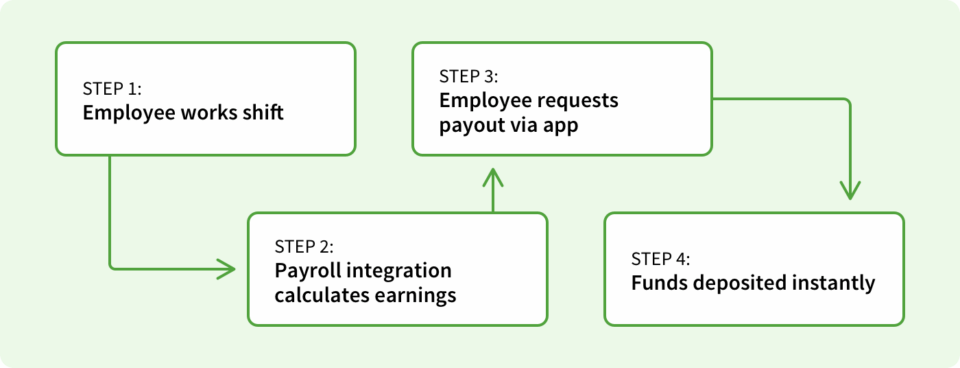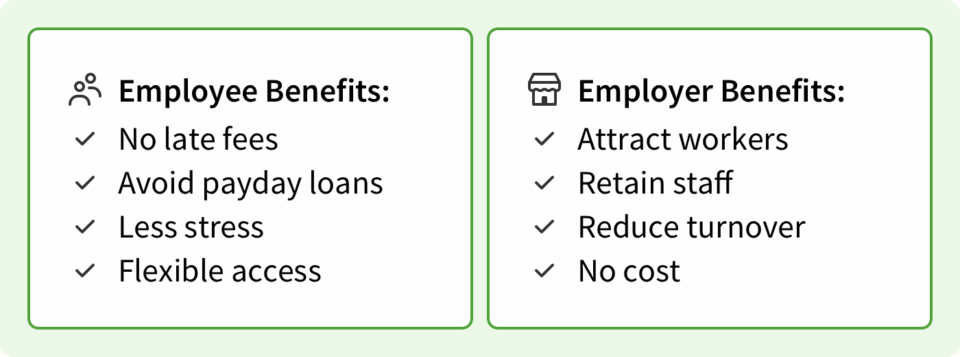On-Demand Pay: How It Works & Benefits For Your Workplace
Try When I Work for free
Most workers are paid on a biweekly basis. While this has been standard practice for nearly 100 years, is it the right way to do things?
Because of the way paydays have always worked, many Americans live with constant financial stress and instability. Today, 50% of all adults would have difficulty paying for a $400 emergency expense, with one in five not being able to pay the expense at all. This means in tight times, millions turn to payday lenders or other sources to make ends meet in between paycycles. But it doesn’t have to be this way if workers can access what they’ve already earned and have more flexibility around their cash flow.
Employees should be able to access their earnings for the work they do each day. That’s where on-demand pay comes in.
Looking to learn more about on-demand pay or earned wage access? Keep reading or watch our YouTube video! You’ll see what on-demand pay is, how it works, why you should offer it, and how you can get started.
What is on-demand pay and how does it actually work?
On-demand pay means employees have access to their money as they earn it. You may hear it called payroll on demand, wages on demand, instant pay, or even earned wage access.

Traditionally, you aren’t calculating payroll in real time. It’s something that’s tabulated over the cumulative pay period (which is what the pay periods are for). That makes the idea of on-demand pay seem like a huge change. How can employers pay any employee at any given moment what they’re owed?
New business models are emerging to help employers solve this challenge, and today, on-demand pay is usually handled through a third-party provider or mobile app system, one that’s integrated into your payroll system.
A standard scenario might be an outside provider that’s integrated to your payroll system using cloud-based technology, calculates how much each employee earns on each shift, and makes that amount available to them should they want to request it.
It’s real-time access to real-time earnings.
Why offer on-demand pay
If you’re not sure if payroll on-demand is right for your workplace, consider the benefits not only to employees, but to managers, too.

- It creates happier employees.
Almost half of employees couldn’t handle a $400 emergency. That means they aren’t just living close to the line, they’re living on it. Having to wait for a future payday, and then waiting for their paycheck or bank deposit to clear the bank, means late payments and added fees for bills that are overdue.
By giving your employees the ability to get to their money before payday means they don’t have to suffer from the financial burden of late fees, or turn to predatory payday loans or credit card debt to cover their needs. Emergencies are less stressful because they can access the money they’ve already earned whenever they need it.
Less stress means happier employees.
- It’s a no-cost benefit to attract workers.
In a tight labor market, employers need to find every last benefit they can in order to attract workers. Offering on-demand pay is part of telling potential employees that you care about their financial wellness.
A recent study revealed that 66% of workers want earlier access to the money they’ve earned to cover bills and emergency expenses. By offering access to their pay when they need it, you’re creating an attractive benefit for your employees—one your competitors aren’t offering—at no cost to your bottom line.
- It reduces your turnover costs.
Just as benefits attract workers, good benefits that aren’t found elsewhere can help keep them. The difference between you and a competitor might simply be that employees get earned wage access. And for that, they’ll stick with you. You can save money with less employee turnover, and offering this benefit has been shown to reduce turnover by 40%.
How to get started with on-demand pay
There are a few things to consider before taking the leap to on-demand pay.
First, on-demand pay is all about giving your employees flexibility in their finances. Whether you have hourly or salaried workers, the service you provide should be able to accommodate both.

Then, you’ll want to choose a provider that works with your business. Look for one with a solid mobile component, where both managers and employees can manage work schedules, time clock, team communication, and wages on demand from their mobile device.
It’s also important to make sure you find an on-demand pay provider that’s free for your employees to use. Otherwise, you aren’t really helping them advance their financial wellness if they have to pay to access their wages sooner.
If all of this sounds like too much fuss, and you think it’s easier just to keep using a traditional payroll approach, imagine being one flu or flat tire away from missing a rent payment.
Without access to their money when they need it, your employees are placed in that precarious position every day. Giving them more control over their financial wellbeing helps them be happier and more productive at work. That’s why When I Work has teamed up with Clair, a no-fee on-demand pay provider, making it easy for you to get started. There are no changes to your payroll procedures or disruptions to cash flow, and Clair is free for both employers and employees. Contact us today to find out more about how on-demand pay might work with your team.






